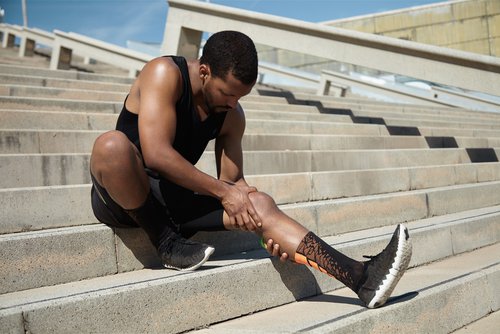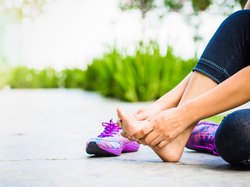 Muscle cramps happen to everyone, whether you’re a star athlete or just getting in your weekly cardio at the gym. But just because they’re common doesn’t mean they don’t hurt -- nor does it mean they’re unavoidable, or that they happen for no reason.
Muscle cramps happen to everyone, whether you’re a star athlete or just getting in your weekly cardio at the gym. But just because they’re common doesn’t mean they don’t hurt -- nor does it mean they’re unavoidable, or that they happen for no reason.
AtBarrington Orthopedic Specialists, we want our patients to understand what’s going on in their bodies when they hurt. Here are a few reasons why you may be experiencing muscle cramps, as well as some tips on how you can prevent them from happening in the future:
What is a Muscle Cramp?
A muscle cramp is a sudden and involuntary muscle contraction of one or more muscles. This can happen in any muscle, but it most commonly occurs in the legs and feet. The affected muscle may feel hard to the touch and can last anywhere from a few seconds to several minutes. These involuntary contractions can range from mild to extremely painful.
The exact cause of muscle cramps is unknown, but some of the risk factors may include poor physical condition, dehydration and muscle fatigue.
Your Muscles Are Dehydrated
One of the most common reasons why you may experience muscle contractions during and after exercise is dehydration. This becomes a particular risk during the summer months when hot weather can sap the water andelectrolytes from your body even quicker than usual. While external heat can certainly be a factor, the heat that creates muscle dehydration actually comes from your muscles themselves. As you use them, they create friction within your body, and can ultimately seize due to their own heat. To you, this occurrence feels like a painful cramp.
If you’re looking to prevent muscle cramps due to dehydration, the answer is fairly simple: hydrate the rest of your body! Be sure you’re drinking the appropriate amount of fluids for your body type, activity level, and environmental conditions. This is especially important during periods of exercise.
The Muscle Has Been Strained
Muscle strains are common injuries, but sometimes, you don’t know you’ve strained a muscle until you try to use it during exercise and you’re met with a painful cramp. Strains can happen for a wide variety of reasons, some of which seem relatively low-impact -- maybe you slept on the muscle in an improper position, used it extensively after a sedentary period, or overworked it on the job or during a previous exercise session.
Regardless of the source of your strain, one of the best ways to prevent the injury from happening in the first place is by stretching your muscles every day. It’s imperative to stretch sufficiently before any sort of exercise -- muscles that haven’t been properly warmed up are stiff, making them significantly more susceptible to injury than stretched, flexible tissue.
You Have an Underlying Condition
A muscle cramp, also known as a charley horse, is common, and they rarely cause concern -- but there are a few significant underlying conditions for which chronic muscle cramping can serve as a red flag. These conditions include:
- Nerve compression: Cramping can be a symptom of lumbar stenosis, a condition in which the nerves in your spine can become compressed and cause pain in the lower extremities.
- Narrowed arteries: Certain cardiovascular conditions can cause the arteries that deliver blood to your legs to contract, causing cramps when you attempt to exercise.
- Mineral deficiencies: If your body isn’t receiving enough calcium, magnesium, or potassium as part of your regular diet, you may be more susceptible to leg cramping.
Not all cramps should be cause for alarm, but if you’re experiencing any of the following symptoms, it may be time to see an orthopedic specialist:
- Cause severe pain and discomfort
- Come out of nowhere
- Chronic, happening constantly
- Cause muscle weakness and muscle fatigue
- Legs are also swollen or red
- Cramps are not improving even with preventative measures
If you’re concerned about the severity or frequency of your muscle cramps, or you’re unsure about best practices for preventing cramps during exercise, theFitness Enhancement Programs at Barrington Orthopedic Specialists can help. Our fitness enhancement programs were designed to give you the guidance you need to exercise safely and meet your individual goals!
To be scheduled with a physician at Barrington Orthopedic Specialists, contact our office at (847) 285-4200 or schedule onlinehere.
For urgent needs when our physician’s offices are closed, visit ourImmediate Orthopedic Care (IOC) in Schaumburg, Illinois.
Frequently Asked Questions
What's the difference between leg cramps and restless legs syndrome (RLS)?
Although both nocturnal leg cramps (leg cramps at night) and restless legs syndrome (RLS) are common conditions that happen at night and can interfere with sleep, there is a distinct difference between the two. Leg cramps are sudden contractions of one or more leg muscles, causing sharp pain that typically lasts for a few seconds to several minutes. While RLS is a neurological disorder that causes an overwhelming urge to move your legs, usually accompanied by uncomfortable sensations such as tingling, crawling, or burning.
How to treat muscle cramps?
The treatment for cramping muscle can vary depending on the cause and severity of the cramp. In most cases, mild to moderate cramps can be treated at home by gently stretching and massaging the affected muscle. Heat or ice therapy may also help relieve pain and discomfort. For more severe or persistent cramps, it's important to consult with a medical professional to determine the best course of treatment.
Can stretching help prevent muscle cramps?
A regular program of stretching lengthens muscle fibers, making them more pliable and reducing the chance of injury. Stretching can also help prevent muscle cramps during and after exercise by promoting blood flow and increasing range of motion in the affected muscles.
